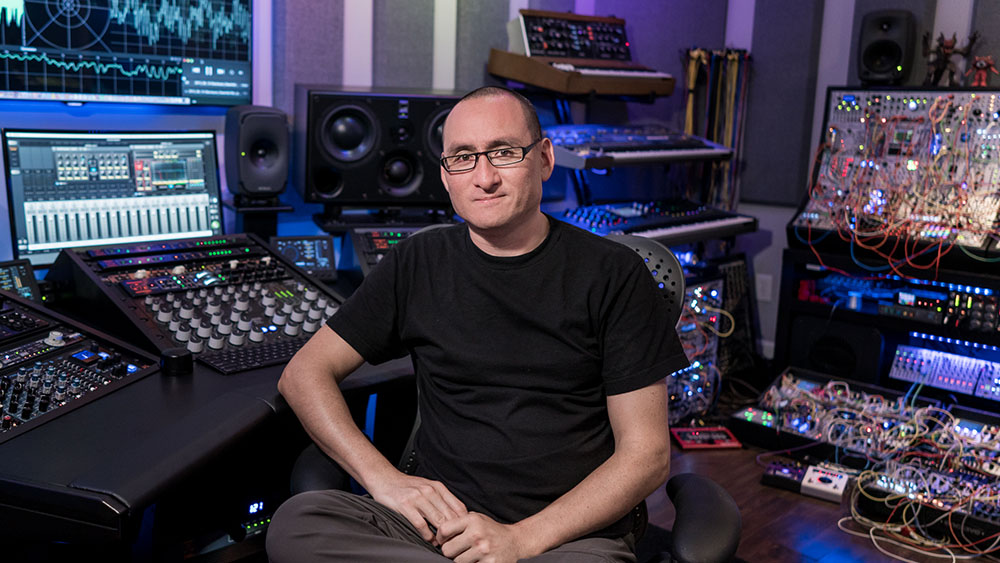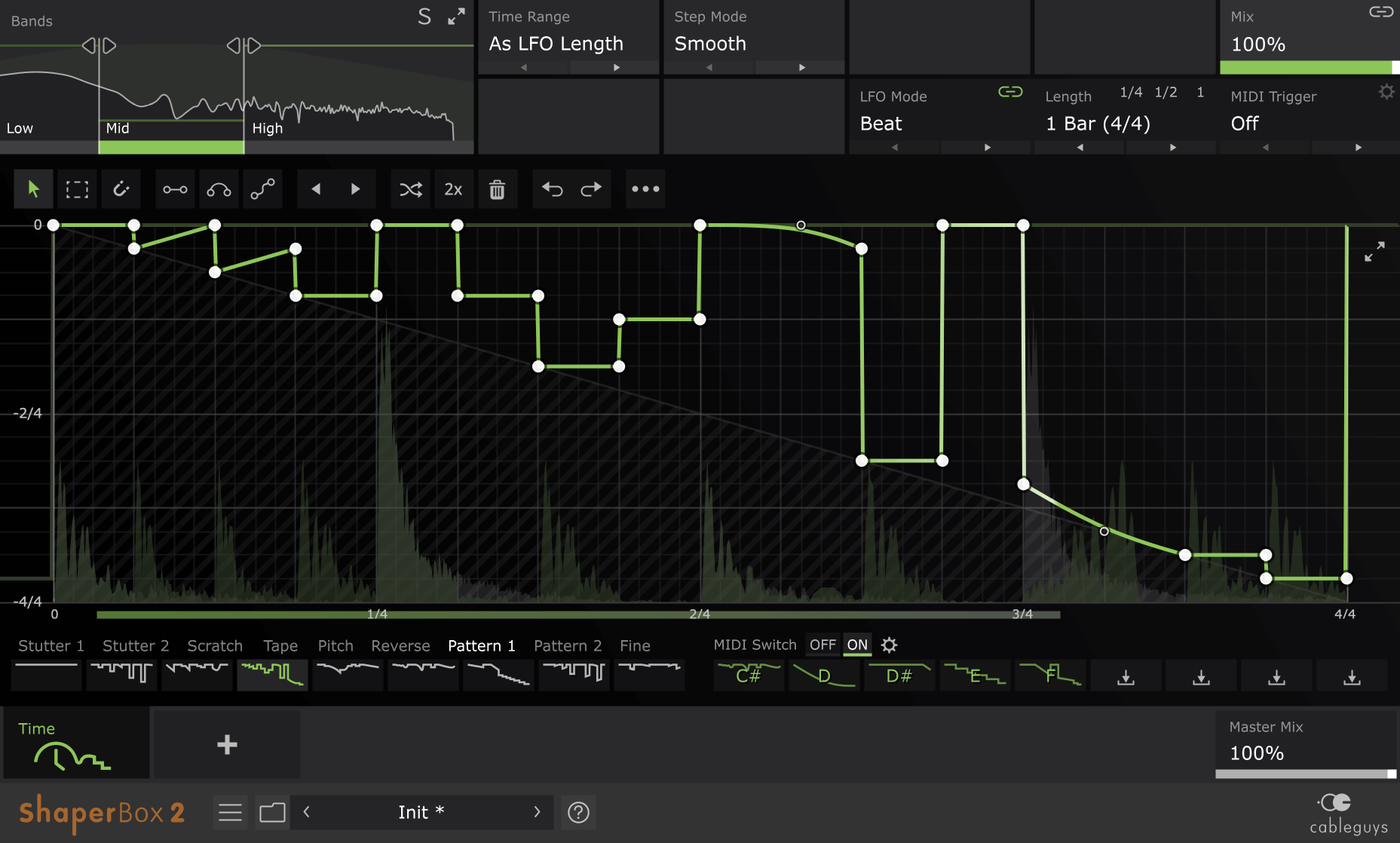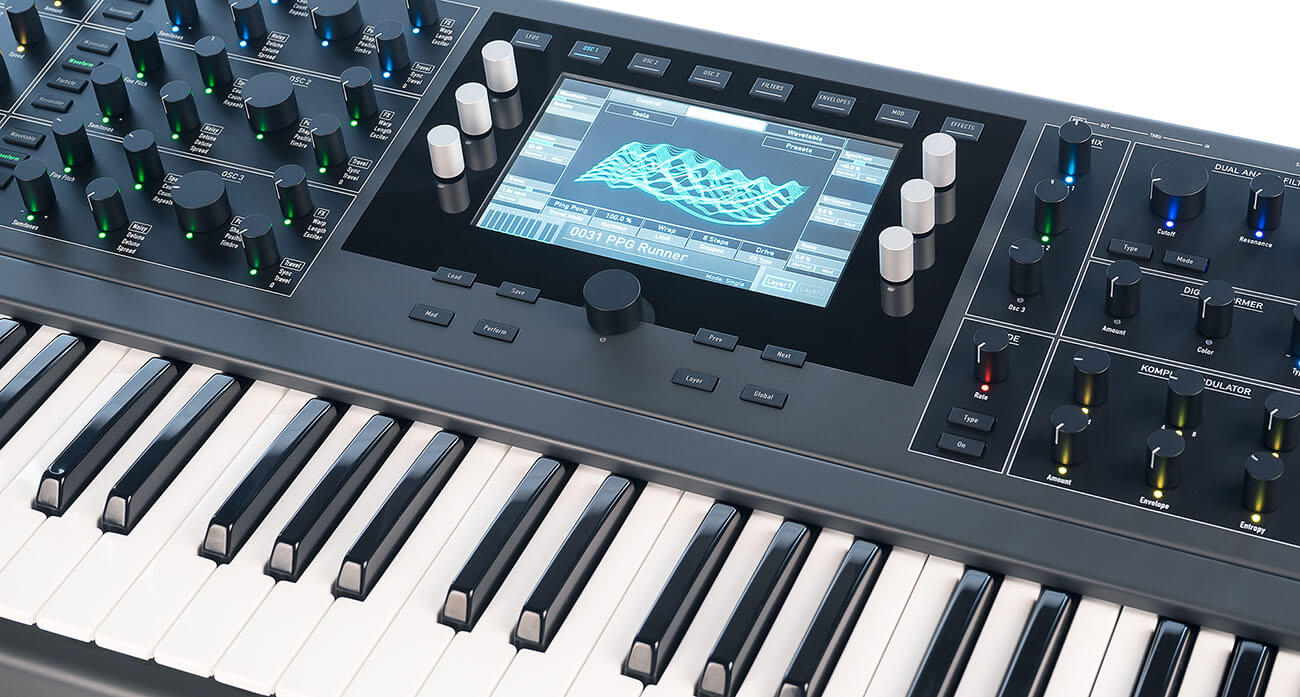
Known for his cerebral sonic styling and intrepid compositional approach, Atlanta-born producer Richard Devine is a true champion of computer-generated music. Over almost 30 years and seven albums – from the pounding techno of 1995’s 'Sculpt' through to 2018’s multidimensional 'Sort\Lave' – his artful tracks have consistently pushed boundaries, animated dancefloors and challenged aesthetic preconceptions.
Alongside his pioneering music production work, Richard is equally renowned as a sound designer, constructing audio components for movies, games and corporate clients, and making presets for numerous high-profile plugin effects and synths – including ShaperBox 2. His 12-strong preset pack for our LFO-driven effects plugin draws on all seven Shapers to define a playground of time-bending, filter-flinging, beat-shattering experimentalism. Here, Richard discusses the creation of the pack, how ShaperBox fits into his musical arsenal and more.
“I think a great preset should make you stop and go, ‘Wow, this is doing something really unique’, and should instantly grab your attention. It should also be able to work on a wide variety of different materials: vocals, guitars, synths, drums, sequenced loops, etc. It should invoke new ideas or suddenly become a new interesting Lego piece that you could instantly add to your music composition or sound effect.
“I always try and test on various tonal and non-tonal materials. I also like to do a few passes with automating the various controls in my patches to make sure they’re all moving the parameters in the right ranges. It's a tedious process, but the extra time spent is usually well worth it in the end.”
“I try to make sure that even if the sound appears to be atonal, it still has some frequency or harmonic cluster that hints at some sort of harmonic frequency. At first listen, my sounds might sound completely like noise to the average listener; but if you listen closer, you’ll hear that each piece is carefully placed in the mix, and has a specific tone, gesture or purpose. I try to make each piece have a function that hopefully carries the composition along and is almost like telling a story, in a way.”
“I used VolumeShaper and TimeShaper very heavily on dozens of audio stems that I tracked from my modular during that period. It was such a great way to process sounds that I would then feed back into my ER-301 Sound Computer module. The way you can alter and shape the amplitude of the signals [with ShaperBox] is astonishing, and with such precise control, it was my go to tool for creating new wild modulation waveshapes.
“On tracks like 'Sentik Pin', you can hear how TimeShaper was used to alter the fluctuation of flowing push and pull-like sounds within the rhythms. This was very interesting, and it would be almost impossible to accomplish this type of effect with the Eurorack modular alone.”
Hear TimeShaper warp the very fabric of time in Richard Devine's 'Sentik Pin'
“I actually find it very interesting that not a lot of experimental producers have heard about the ShaperBox plugin. I honestly feel it's better suited for experimental music than for EDM and typical dance music. I love that it's so fast and easy to use. You guys spent a lot of time designing this incredible real-time wave display input interface. Being able to customize the breakpoints and timing is genius, and having a library of different breakpoint shapes to choose from is also so nice for quickly getting you going on something.
“I used the ShaperBox plugin extensively on the sound design for the new Cyberpunk 2077 game. It was one of my main plugins for generating those mangled half-time skeletal construction beats.
“I’ve stored so many great channel strip presets with the Cableguys plugins. VolumeShaper and TimeShaper 2, are almost always in those chains together, for these types of projects.”
“I would have to say TimeShaper 2. The way you can bend the pitch and timing of the sound is absolutely amazing – I love what it does with raw percussion loops and rhythmic textures. It can instantly transform even the most simple beats into complex warping, flexing, pulsing sounds. It's almost like you can take a simple loop and conform it into a rubber band, and bend, stretch and pull it any way you want. There is really nothing else like it.”

Do you want to bend, stretch and transform sound like Richard Devine? Then TimeShaper is the Shaper for you!
“It would have to be the Waldorf Quantum synthesizer – by far one of the most inspiring digital synthesizers to come out in the last ten years. You have so many incredible options for creating and manipulating your sounds. There are Particle/Granular, Additive/Subtractive, Kernel FM, Wavetable and Physical Modeling modes as sound sources that can be used in any combination. The mod matrix is incredibly deep, with the ability to modulate almost any parameter with a wide variety of different control sources; and the touchscreen and layout are absolutely stunning. It's just a joy to use and make music and new sounds on.”

More than just a box of advanced synthesis algorithms, Richard prizes the Waldorf Quantum for the inspiration and sheer musical joy that it gives
“I’ve been a ShaperBox user since day one, and I just love the way you can shift the timing, pitch, shape, and timbre of the incoming signal. For my presets, I really tried to take advantage of those features and create, hopefully, an inspiring small collection of presets that would be fun to use on all types of material. These patches are from my personal collection that I’ve actually used on many of my own tracks and projects.
“The goal with any of my presets is to create an inspirational springboard for users to work from.”
Richard Devine has crafted a 12-strong pack of inspirational ShaperBox 2 presets
“Some of the most extreme sounds I’ve made are actually recordings of situations out in the wild. Some of the strangest, most extreme sounds I’ve found are right in my back yard! Here are a few examples…
“One was this recording of a homemade Jacob's ladder, also known as the ‘high voltage traveling arc’. It was extremely dangerous. I was recording it with my father-in-law – you could see the electrical arcs flying in the air, and I got shocked several times, and even burned up one of my microphone capsules. The sound was the most intense electrical zaps/arcs I have ever heard. You can take a listen here:
“Another extreme recording I did was a multi-channel field recording of 12,000 Italian bees at Buckeye Creek Farm, Cherokee, GA. The setup consisted of four wooden packages, containing 3000 bees each, stacked on top of each other to create a wall of swarming noise. I captured it with the Neumann RSM 191-A/S and DPA SMK 4060 omnidirectional miniature stereo microphones. The sound was terrifying, and the volume of that many bees was so intimidating. If you’re interested, take a listen...
Follow Richard Devine on Instagram.
To get Richard's preset pack, simply sync your ShaperBox 2 library by clicking the Sync button in the Preset Browser, then click the Full Search tab and enter 'Devine' in the Creator search field.

Download Curve 2.6.3 Demo (VST / AU / AAX):
WINDOWS
Windows 7 or later
MAC
OS X 10.9 or later
The demo is fully functional and has no time limit, but you can only use one instance per song and you can't save your settings.
Download FilterShaper XL 1.0.4 Demo (VST / AU / AAX):
WINDOWS
Windows 7 or later
MAC
macOS 10.13 or later
The demo is fully functional and has no time limit, but you can only use one instance per song and you can't save your settings.
Download HalfTime 1.1.11 Demo (VST / AU / AAX):
WINDOWS
Windows 7 or later
MAC
OS X 10.9 or later
The demo is fully functional and has no time limit, but you can only use one instance per song and you can't save your settings.
Download Kickstart 2.0.7 Demo (VST / AU / AAX):
WINDOWS
Windows 7 or later
MAC
OS X 10.9 or later
The demo is fully functional and has no time limit, but you can only use one instance per song and you can't save your settings.
Download MidiShaper 1.6 Demo (VST / AU):
WINDOWS
Windows 7 or later
MAC
macOS 10.13 or later
The demo is fully functional and has no time limit, but you can only use one instance per song and you can't save your settings.
Download PanCake 2.3.1 (VST / AU, 32 / 64bit):
WINDOWS
Windows 7 or later
MAC
OS X 10.8 or later
PanCake is completely free.
Download ShaperBox 3.5.4 Demo (VST / AU / AAX)
— includes ReverbShaper, TimeShaper 3, DriveShaper 2, NoiseShaper 2, FilterShaper Core 3, LiquidShaper, CrushShaper 2, VolumeShaper 7, PanShaper 4, WidthShaper 3:
WINDOWS
Windows 7 or later
MAC
macOS 10.13 or later
The demo is fully functional and has no time limit, but you can only use one instance per song and you can't save your settings.
Download Snapback 1.0.2 Demo (VST / AU / AAX):
WINDOWS
Windows 7 or later
MAC
macOS 10.13 or later
The demo is fully functional and has no time limit, but you can only use one instance per song and you can't save your settings.
Download ShaperBox 3.5.4 Demo (VST / AU / AAX)
— includes ReverbShaper, TimeShaper 3, DriveShaper 2, NoiseShaper 2, FilterShaper Core 3, LiquidShaper, CrushShaper 2, VolumeShaper 7, PanShaper 4, WidthShaper 3:
WINDOWS
Windows 7 or later
MAC
macOS 10.13 or later
The demo is fully functional and has no time limit, but you can only use one instance per song and you can't save your settings.
Download ShaperBox 3.5.4 Demo (VST / AU / AAX)
— includes ReverbShaper, TimeShaper 3, DriveShaper 2, NoiseShaper 2, FilterShaper Core 3, LiquidShaper, CrushShaper 2, VolumeShaper 7, PanShaper 4, WidthShaper 3:
WINDOWS
Windows 7 or later
MAC
macOS 10.13 or later
The demo is fully functional and has no time limit, but you can only use one instance per song and you can't save your settings.
Download ShaperBox 3.5.4 Demo (VST / AU / AAX)
— includes ReverbShaper, TimeShaper 3, DriveShaper 2, NoiseShaper 2, FilterShaper Core 3, LiquidShaper, CrushShaper 2, VolumeShaper 7, PanShaper 4, WidthShaper 3:
WINDOWS
Windows 7 or later
MAC
macOS 10.13 or later
The demo is fully functional and has no time limit, but you can only use one instance per song and you can't save your settings.
Download ShaperBox 3.5.4 Demo (VST / AU / AAX)
— includes ReverbShaper, TimeShaper 3, DriveShaper 2, NoiseShaper 2, FilterShaper Core 3, LiquidShaper, CrushShaper 2, VolumeShaper 7, PanShaper 4, WidthShaper 3:
WINDOWS
Windows 7 or later
MAC
macOS 10.13 or later
The demo is fully functional and has no time limit, but you can only use one instance per song and you can't save your settings.
Download ShaperBox 3.5.4 Demo (VST / AU / AAX)
— includes ReverbShaper, TimeShaper 3, DriveShaper 2, NoiseShaper 2, FilterShaper Core 3, LiquidShaper, CrushShaper 2, VolumeShaper 7, PanShaper 4, WidthShaper 3:
WINDOWS
Windows 7 or later
MAC
macOS 10.13 or later
The demo is fully functional and has no time limit, but you can only use one instance per song and you can't save your settings.
Download ShaperBox 3.5.4 Demo (VST / AU / AAX)
— includes ReverbShaper, TimeShaper 3, DriveShaper 2, NoiseShaper 2, FilterShaper Core 3, LiquidShaper, CrushShaper 2, VolumeShaper 7, PanShaper 4, WidthShaper 3:
WINDOWS
Windows 7 or later
MAC
macOS 10.13 or later
The demo is fully functional and has no time limit, but you can only use one instance per song and you can't save your settings.
Download ShaperBox 3.5.4 Demo (VST / AU / AAX)
— includes ReverbShaper, TimeShaper 3, DriveShaper 2, NoiseShaper 2, FilterShaper Core 3, LiquidShaper, CrushShaper 2, VolumeShaper 7, PanShaper 4, WidthShaper 3:
WINDOWS
Windows 7 or later
MAC
macOS 10.13 or later
The demo is fully functional and has no time limit, but you can only use one instance per song and you can't save your settings.
Download ShaperBox 3.5.4 Demo (VST / AU / AAX)
— includes ReverbShaper, TimeShaper 3, DriveShaper 2, NoiseShaper 2, FilterShaper Core 3, LiquidShaper, CrushShaper 2, VolumeShaper 7, PanShaper 4, WidthShaper 3:
WINDOWS
Windows 7 or later
MAC
macOS 10.13 or later
The demo is fully functional and has no time limit, but you can only use one instance per song and you can't save your settings.
Download ShaperBox 3.5.4 Demo (VST / AU / AAX)
— includes ReverbShaper, TimeShaper 3, DriveShaper 2, NoiseShaper 2, FilterShaper Core 3, LiquidShaper, CrushShaper 2, VolumeShaper 7, PanShaper 4, WidthShaper 3:
WINDOWS
Windows 7 or later
MAC
macOS 10.13 or later
The demo is fully functional and has no time limit, but you can only use one instance per song and you can't save your settings.
Download ShaperBox 3.5.4 Demo (VST / AU / AAX)
— includes ReverbShaper, TimeShaper 3, DriveShaper 2, NoiseShaper 2, FilterShaper Core 3, LiquidShaper, CrushShaper 2, VolumeShaper 7, PanShaper 4, WidthShaper 3:
WINDOWS
Windows 7 or later
MAC
macOS 10.13 or later
The demo is fully functional and has no time limit, but you can only use one instance per song and you can't save your settings.
Buy Snapback Now!
€49 / $49, incl. VAT
Log in for upgrades (including Bundle upgrades).
Buy Curve 2 Now!
€119 / $129, incl. VAT
Log in for upgrades (including Bundle upgrades).
Buy FilterShaper XL Now!
€79 / $79, incl. VAT
Log in for upgrades (including Bundle upgrades).
Buy ReverbShaper Now!
€39 / $39, incl. VAT
Log in for upgrades (including Bundle upgrades).
Buy TimeShaper 3 Now!
€29 / $29, incl. VAT
Log in for upgrades (including Bundle upgrades).
Buy DriveShaper 2 Now!
€39 / $39, incl. VAT
Log in for upgrades (including Bundle upgrades).
Buy NoiseShaper 2 Now!
€39 / $39, incl. VAT
Log in for upgrades (including Bundle upgrades).
Buy FilterShaper Core 3 Now!
€39 / $39, incl. VAT
Log in for upgrades (including Bundle upgrades).
Buy LiquidShaper Now!
€29 / $29, incl. VAT
Log in for upgrades (including Bundle upgrades).
Buy CrushShaper 2 Now!
€39 / $39, incl. VAT
Log in for upgrades (including Bundle upgrades).
Buy VolumeShaper 7 Now!
€29 / $29, incl. VAT
Log in for upgrades (including Bundle upgrades).
Buy PanShaper 4 Now!
€29 / $29, incl. VAT
Log in for upgrades (including Bundle upgrades).
Buy WidthShaper 3 Now!
€29 / $29, incl. VAT
Log in for upgrades (including Bundle upgrades).
Buy HalfTime Now!
€10 / $12, incl. VAT
Log in for upgrades (including Bundle upgrades).
Buy MidiShaper Now!
€49 / $49, incl. VAT
Log in for upgrades (including Bundle upgrades).
Contains ReverbShaper, TimeShaper 3, DriveShaper 2, NoiseShaper 2, FilterShaper Core 3, LiquidShaper, CrushShaper 2, VolumeShaper 7, PanShaper 4, WidthShaper 3
Buy ShaperBox 3 Bundle Now!
€99 / $99, incl. VAT
Log in for upgrades (including Bundle upgrades).
Contains Snapback, Curve 2, FilterShaper XL, ReverbShaper, TimeShaper 3, DriveShaper 2, NoiseShaper 2, FilterShaper Core 3, LiquidShaper, CrushShaper 2, VolumeShaper 7, PanShaper 4, WidthShaper 3, HalfTime, MidiShaper
Buy Cableguys Bundle Now!
€179 / $179, incl. VAT
Log in for upgrades (including Bundle upgrades).
Buy Kickstart 2 Now!
€14 / $16, incl. VAT
Log in for upgrades (including Bundle upgrades).